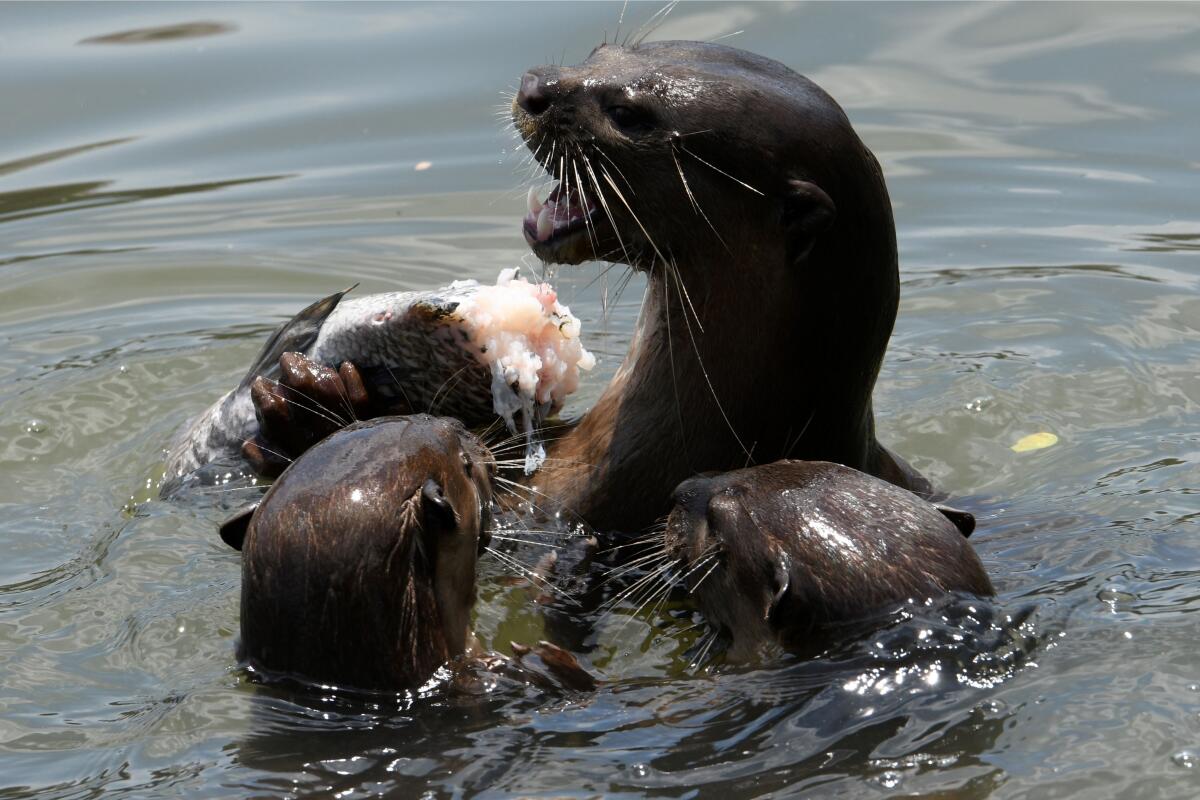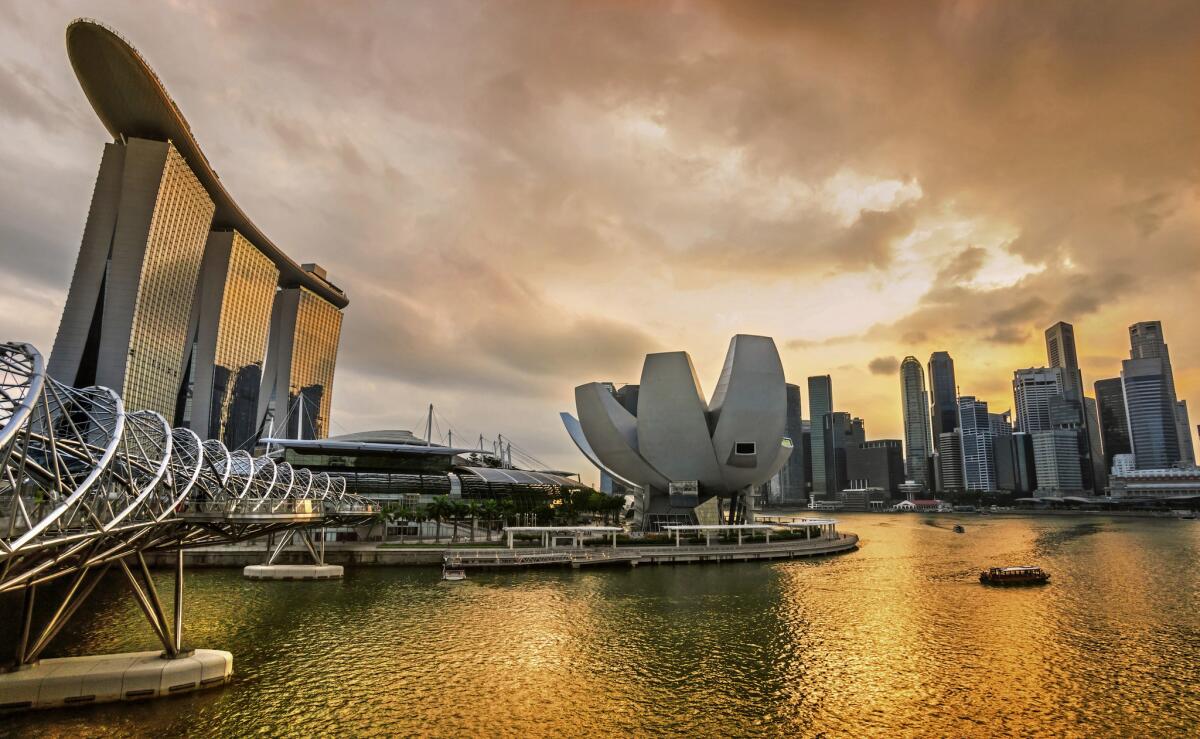Meet the otters who raided a spa during a coronavirus shutdown, sparking outrage

SINGAPORE â Life was already hardscrabble for the seven river otters known as the Zouk family.
Prime land next to Singaporeâs sparkling waterways brimming with fish had been seized by other clans, forcing the hapless group to wander the city-state each day in search of food and shelter. But few noticed their forays until a coronavirus shutdown known as the circuit breaker was imposed in April.
With the streets nearly emptied, the Zouks â named after a local nightclub â started appearing in unexpected places: splashing around in a luxury condominium pool, taking a break outside a usually teeming shopping center in Little India and trying to cut through the lobby of a childrenâs hospital.
It all seemed rather harmless. But calls for a crackdown on the otter population began when the Zouks raided a private pond stocked with expensive ornamental fish on the grounds of a spa owned by a former actress.
âThe otters killed all the fishes in the pond,â Jazreel Low wrote in a Facebook post punctuated by a sad face emoji and what looks like a surveillance camera image of four otters skipping through her temporarily shuttered business. Low later posted a picture of her 13-year-old arowana, Ah Huat â meaning âto prosperâ â in better times.
âDarn otters! They gotta pay for it!â wrote one sympathetic commenter.
Within days, there were calls on social media and a radio program to cull the slippery animals. A widely shared letter published in the local Straits Times recommended deterring otters with air horns and rubber bullets.
âWild boars have never been encouraged to enter urban areas, neither should otters be just because they look cute,â wrote Ong Junkai, an aquaculture products salesman.
It was a harsh response, one that otter lovers reasoned was amplified by the desire to discuss (or complain) about anything other than the coronavirus. It was also unanticipated. Singapore seemed a city captivated by the cuddly creatures â a model of coexistence with urban wildlife.
Ever since 2014, when they started appearing in Marina Bay â the waterfront famed for its Merlion and Marina Bay Sands hotel â the otters have been treated like celebrities in a metropolis otherwise known as the Lion City.
When asked to vote for a mascot to represent Singapore during its 2016 National Day festivities, citizens overwhelmingly chose the otters.
The animals have been given the David Attenborough documentary treatment and have spawned a number of fan pages, including the closely followed Ottercity, a nerve center for the bands of local enthusiasts who track the animalâs movements.
When the patriarch of a beloved family of otters known as the Bishan 10 died in 2018, mourners drew anthropomorphic lessons from the life he led.
âThe Bishan dad was able to keep the family together. When he passed away, there was a lot of reflection among otter watchers about our own lives and our own accomplishments,â said Sivasothi N., a biologist at the National University of Singapore, better known as the Otterman because of his expertise with the animals.
Something about the ottersâ lifestyle provokes envy among Singaporeâs high-achieving and high-strung society.
âThey are exactly who we want to be,â said Jeffrey Teo, Asia Pacific managing director of a French financial services firm and the founder of Ottercity. âThey spend time with family. They like to swim, eat good food and do a little sunbathing.â
The fact the otters are even found here, in one of the densest cities in the world, provokes astonishment. Most species of the semiaquatic animal live solitary lives.
But Singaporeâs prevalent otter, the smooth-coated variety, is unusually social. They swim by row boats, roll in the grass next to tourists and take dips in reservoirs, whose banks double as jogging paths.
âWe have the best otter-watching conditions in the world, no question about it,â said Philip Johns, a biologist at Yale-NUS College, who was so taken by the animals when he arrived in Singapore from the U.S. in 2015 that he abandoned notions of studying colugos, a gliding nocturnal mammal that looks like a cross between a bat and a lemur.
âEvolutionarily speaking, colugos are fascinating,â Johns said. âBut they mostly sit in trees and do nothing. Otters are like wolves. Theyâre like coyotes in water.â
Once thought extinct here, like the Malayan tiger, the otters began reappearing in the 1990s in less urbanized corners before capturing everyoneâs attention in Marina Bay.
Their return is due in part to a massive clean-up of Singaporeâs rivers that began in the 1970s. Dredging of the river bottom muck turned up dead pigs, dogs and chickens. You could smell some rivers before you saw them. But the restored waters brought back an otter banquet: tilapia, catfish and all manner of exotic species, such as the yellow-hued Orinoco peacock bass.

Itâs more than dining, though, that makes Singapore optimal for otters. The diamond-shaped island â roughly the size of the San Fernando Valley â is etched with a network of drains and canals that form a âsubway system for the otters to move around really, really quickly,â Johns said.
Mobility is paramount. Otters are fiercely territorial. And now that Singaporeâs otter population has grown to about 90 animals belonging to 10 families, clashes for choice river banks and fishing waters have grown too.
At first, Singaporeans were horrified that the furry critters were capable of such ferocious fighting. Some tried to break up squabbles with umbrellas.
Battles often begin with a cacophony of squeals that can escalate into fits of biting. Pups are the only casualties, often drowned and found floating. About 10 otters died in Singapore last year from a combination of fighting and vehicle collisions.
The Zouks were first driven from a part of the Singapore River. They ended up in the Botanic Garden but its shallow ponds didnât provide enough fish to raise a family. Thatâs when the Zouks hit the road.
Their spa jaunt this month wasnât the first time otters had made headlines for munching on pets. In 2016, local media reported otters ate tens of thousands of dollarsâ worth of exotic fish from private ponds on exclusive Sentosa Island.
Otter experts suggest building more constrictive fencing and opting for smaller pet fish, which arenât worth the ottersâ attention. Having a security guard on hand couldnât hurt either.
That doesnât satisfy critics like Ong, the author of the letter to the Straits Times, who is convinced more Singaporeans would demand stricter management of the urbanized otters if they werenât scared of a backlash.
âTalking about controlling them in any way is bound to draw negative comments based on emotional response,â said Ong, 38, who has an educational background in biology and biomedical science. He cited an incident in 2017 when an otter bit a 5-year-old girlâs foot at Gardens by the Bay.
âThey have been pampered too much,â Ong said.
The official mantra in Singapore is to watch the animals from a distance. Otters donât react unless they feel threatened.
An official at the National Parks Board said mitigation efforts, such as erecting barriers, were working.
âMost problems are easily solved,â said Adrian Loo, who heads wildlife management for the agency.
Otter watchers such as Teo think the backlash has been overblown. Social media, he said, is showing more sympathy for the animals. About 90% of Singaporeans live in public housing, not the multimillion-dollar detached homes that can support fish ponds.
âItâs just a few loud voices that keep complaining,â Teo said. âMr. and Mrs. Know-It-All Singapore.â
With the coronavirus lockdown likely stretching into July, Teo and his cohorts are finding it difficult to keep track of the otters.
The last time the Zouk family was spotted was earlier this week, back in the Botanic Garden.
âThese guys are survivors, theyâre explorers. Itâs a totally new level of inspiration,â said Teo, 49, who ordinarily begins each day photographing otters at 6:30 a.m. before heading to work.
âSadly, I donât think thereâs any upside for them,â he added. âTheyâre just going to keep running around and crossing streets. When the circuit breaker eases up, cars are going to return to the road. Iâve seen too many accidents.â
More to Read
Sign up for Essential California
The most important California stories and recommendations in your inbox every morning.
You may occasionally receive promotional content from the Los Angeles Times.









